
Full Steam VR support Archives
full Steam VR support Archives
Voices of VR Podcast
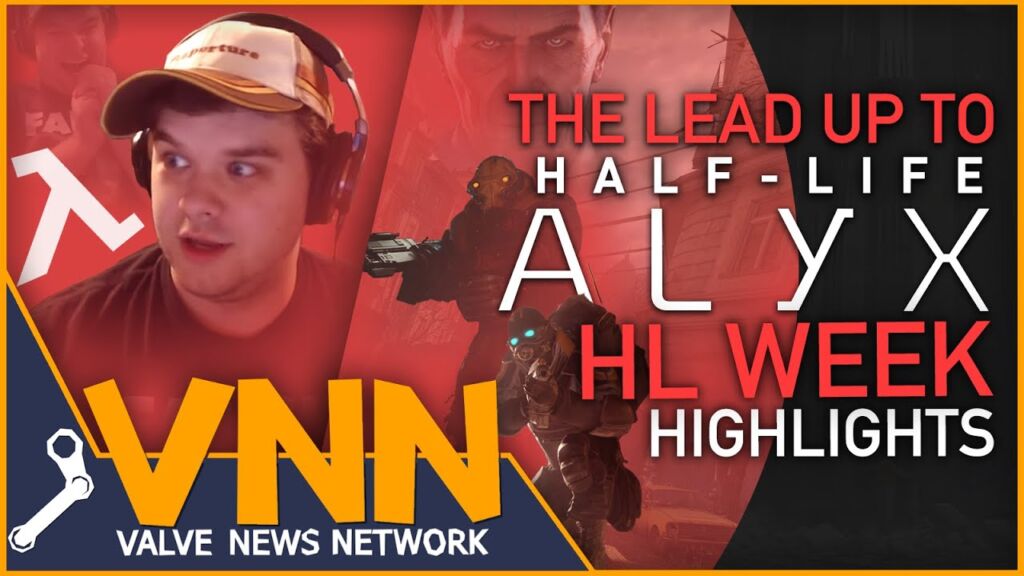
Valve is a critical player in the modern resurgence of VR. They are known for their friendly competitions and cooperation they had with Oculus in the early days of virtual reality spanning from July 2012 to March 20113. Blake Harris’ History of the Future does a great job of laying down a initial timeline (albeit without complete citations as well as an unknown amount of dramatization), but in my interview with Harris he also shared with me beyond very limited conversations with Valve’s Joe Ludwig and Alan Yates, he didn’t have any conversations with any current Valve employees. The only Valve representatives he was able to talk with were former Valve folks who left to work at Oculus. Harris had access to some e-mail correspondence between Oculus and Valve, but in the absence of Valve’s participation, the overall perspective captured in Harris’ book is heavily influenced by Facebook’s side of the story.
On Monday, May 23, 2016, Valve’s Alan Yates responded to a thread on Reddit titled “Oculus becoming bad for VR industry?” after Revive stopped working after an Oculus Update. Responding to eposnix’s comment that “Competition drives innovation and [the Oculus Rift is] the only reason the Vive has its feature set to begin with.” Yates chimed in to say,
While that is generally true in this case every core feature of both the Rift and Vive HMDs are directly derived from Valve’s research program. Oculus has their own [Computer Vision]-based tracking implementation and frensel lens design but the [Oculus Rift Consumer Version #1] is otherwise a direct copy of the architecture of the 1080p Steam Sight prototype Valve lent Oculus when we installed a copy of the “Valve Room” at their headquarters. I would call Oculus the first SteamVR licensee, but history will likely record a somewhat different term for it…
For me, this was a pretty explosive allegation, and on May 24, 2016 UploadVR’s Ian Hamilton wrote a piece called “Inside The Growing Rift Between Valve And Oculus” where he shows an image of Mark Zuckerberg trying out the Valve Room demo in Oculus’ offices on January 29, 2014 — just 55 days before Facebook’s deal to acquire Oculus was announced on March 25, 2014.
This blurry photo of a @brendaniribe presentation shows Zuckerberg trying "Valve prototype" before buying @oculus. pic.twitter.com/lFrm8ZrvY5
— Ian Hamilton (@hmltn) February 26, 2015
Did Zuckerberg know that he was demoing Valve’s technology here? Did the investors from Andreessen Horowitz know that they were trying out some of Valve’s technology when they came to demo the Valve Room demo at Oculus’ offices in Irvine, CA? Blake Harris reports in History of the Future that on October 31, 2013 Marc Andreessen, Chris Dixon, Brian Cho & Gil Shafir “visited Irvine to check out the progress of Oculus. And over the course of several hours, the folks from Andreessen Horowitz found themselves quite impressed.”
Iribe was able to experience VR without any motion sickness after seeing the Valve Room demo at Valve’s offices in Bellvue, WA in September 2013. He was in the process of trying to raise a Series B round in his talk at the Gamer Insider Summit on October 17, 2013 where IGN reported that he said,
“I’ve gotten sick every time I’ve tried [Rift],” Iribe said. He stated that, after just a couple minutes, he feels ill and tends to stop using his company’s own device. “In the last couple weeks, I’ve tried a prototype internally where I did not get sick for the first time, and I stayed in there for 45 minutes.”
Again, it’s unclear under which contexts Iribe was sharing with people that this breakthrough “internal prototype” was actually Valve’s technology. Whether it was disclosed or not may be a moot point now, but what’s important is that Valve has been a crucial driver of innovation in VR, even to this day. However, Valve is a private company in every meaning of the word, and they have not talked much publicly about some of this history, especially when it comes to their past relationship with Oculus.
Valve News Network’s Tyler McVicker has been reporting on Valve for over 10 years now as a fan / investigative journalist / archivist / historian / digital archeologist. He’s got some deep insights into the history of the projects Valve has been working on, the culture of the company, and what motivating Valve to get into VR in the first place. So I wanted to talk to McVicker to get some deeper context on Valve, why they’re so hard to communicate with (he referred to this Steam Dev Days talk by Robin Walker which comprehensively explains Valve’s philosophy when it comes to “external communication”), how he’s able to break stories about Valve by hacking into game patches and Source 2 function calls, what he thinks happened between Valve and Oculus, why he thinks Abrash is the bad guy in this story, and some more about his personal experiences with Half-Life: Alyx, and the underlying motivations for why he does what he does in covering Valve.
LISTEN TO THIS EPISODE OF THE VOICES OF VR PODCAST
TIMELINE OF VALVE’S COLLABORATION WITH OCULUS + VR Events
After I interviewed McVicker, I went through Harris’ History of the Future to record a specific timeline of the relationship between Oculus and Valve. Harris told me in my interview with him that he had to cut out a lot of information about the relationship between Oculus and Valve due to space considerations, but there’s actually a lot that’s on the public record about the cooperation and collaboration between Oculus and Valve. I didn’t buy my Oculus DK1 until January 1, 2014, and so I was not observing in real-time what was happening with VR between August 2012 and December 2013.
At GDC 2015, Valve was showing off the HTC Vive room-scale VR demos to developers and VIPs in the gaming industry. I was not able to get a demo slot at the time, but I was able to sneak in behind the scenes and take some photos of this mini museum that they had set up.
My full Twitter thread of these photos is here, and the dates are from Road to VR’s coverage who were able to get more dates at the time.
A 16-part visual history of @SteamVR Vive.
Original fiducial-based positional tracking used April Tag format, 1/16 pic.twitter.com/Mts7eUXrFQ— Kent Bye VoicesOfVR (@kentbye) March 10, 2015
Fiducial-based Positional Tracking – May 2012

Telescope Low-Persistence Prototype – January 2013

First Low-Persistence AMOLED Panel – January 2013
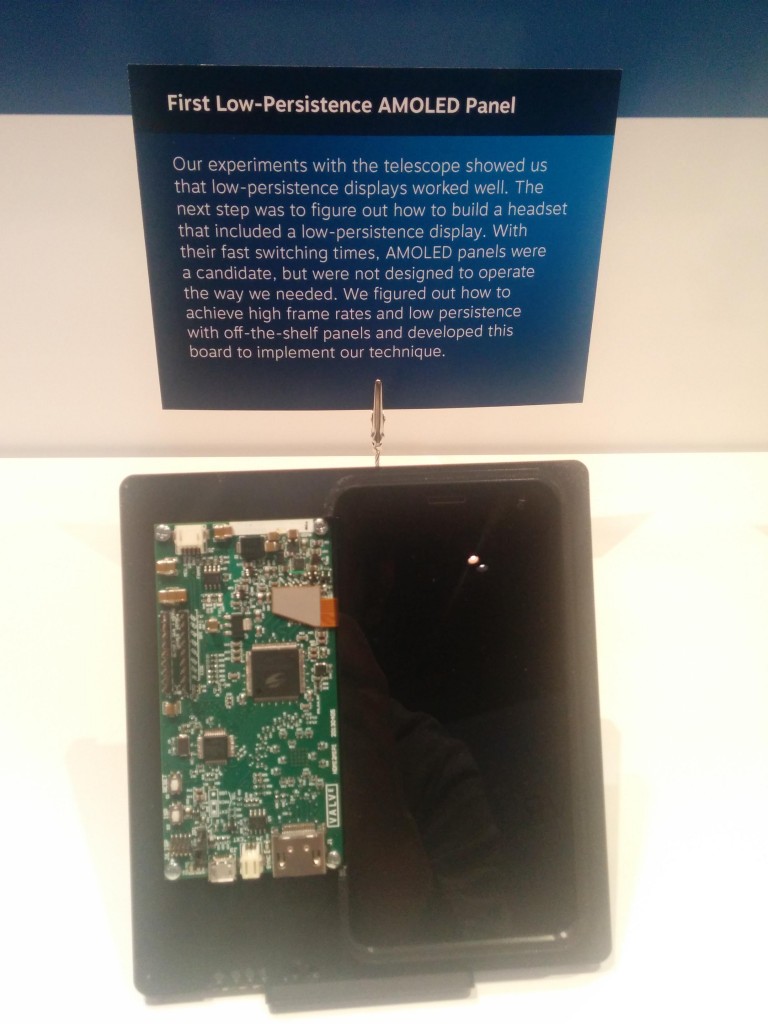
Team Fortress 2 “VR Mode” Shipped – March 2013

Early Low-Persistence Headset – April 2013
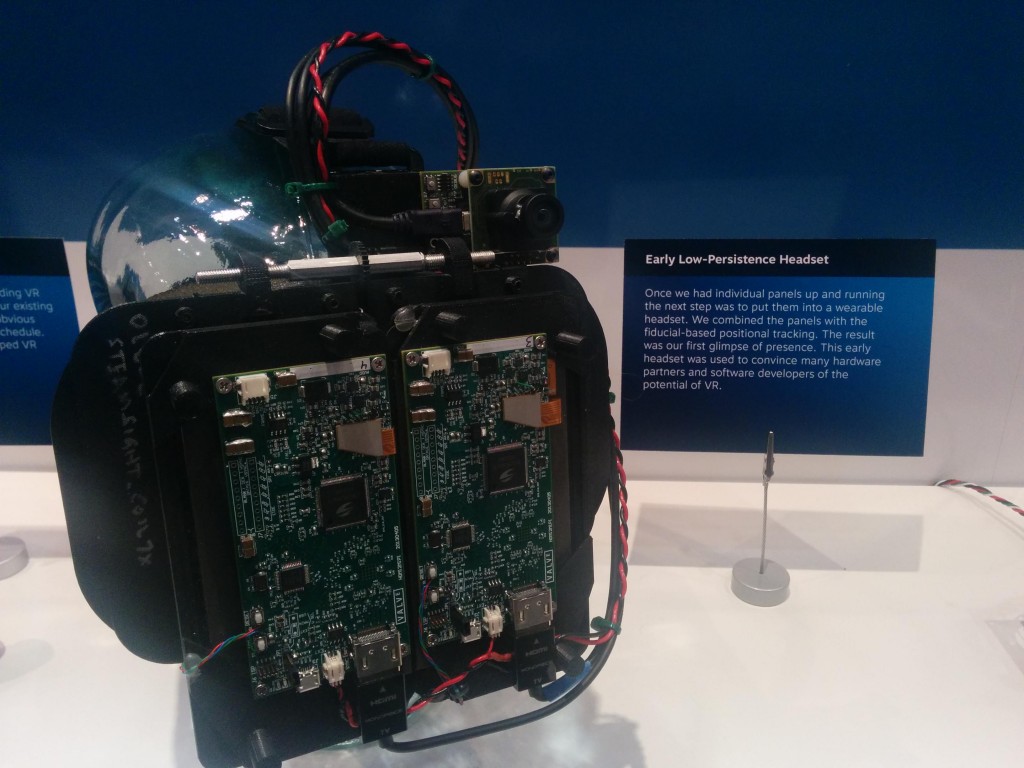
Early Laser Tracking System – September 2013
“The Room” Demo – September 2013
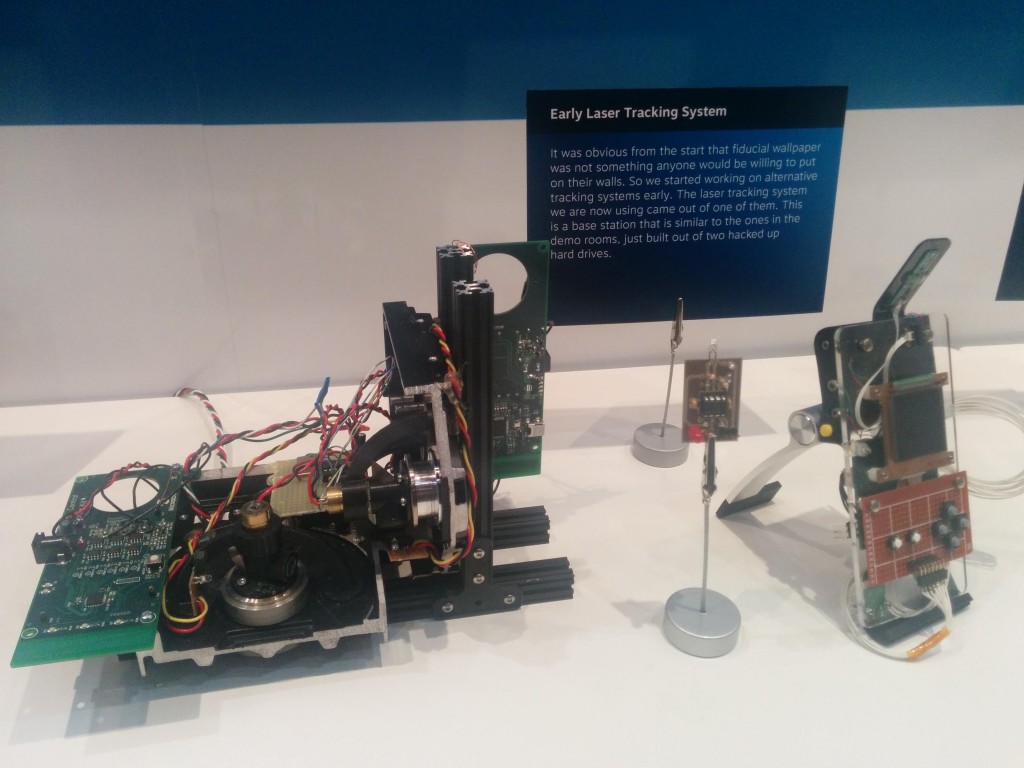
Desktop Dot Tracking and Controllers – October 2013

Steam VR Arrives and “The Room” Demo’d to Public – January 2014

First Laser Tracked Headset – May 2014

First Laser-Tracked Input – October 2014

V minus-1 Headset – November 2014

VR Controller Prototype – December 2014

Miniaturized Laser Base Station – February 2015
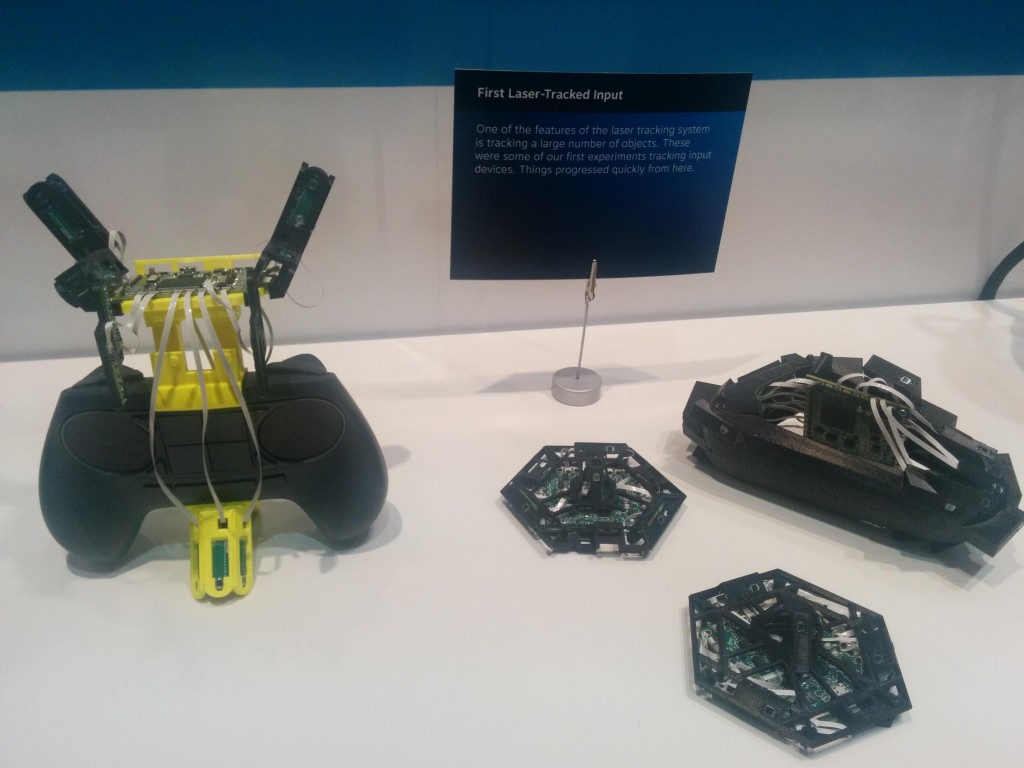
HTC Vive Dev Headset – March 2015



NOTE: I originally posted this timeline on August 28, 2020, but I will be updating it as I find more information and context.
July 26-27, 2012
Oculus’ Palmer Luckey & Michael Antonov go to Valve to meet with Michael Abrash and Gabe Newell and show them an early Oculus Rift Prototype in order to get a quote for their Kickstarter Video.
(History of the Future, pg 114-129)
Late July 2012
Days before Oculus Kickstarter Launch, Valve’s Michael Abrash & Gabe Newell submit video testimony for the Oculus Kickstarter pitch video.
(History of the Future, pg 133)
Aug. 01, 2012
Oculus Kickstarter launches
Archival link of first day: https://web.archive.org/web/20120801212942/https://www.kickstarter.com/projects/1523379957/oculus-rift-step-into-the-game
https://www.kickstarter.com/projects/1523379957/oculus-rift-step-into-the-game
12:14 PM · Aug 1, 2012
First Oculus Tweet from @Oculus3D
We've reached Kickstarter our goal in our very first day! Thank you all for the support!
— Oculus (@oculus) August 1, 2012
August 2, 2012
Thank you!
First blog post from Oculus after reaching their Kickstarter goal
https://www.oculus.com/blog/thank-you/
5:50 PM · August 2, 2012
Wow– We've reached $1 million in less than 36 hours! Thank you so much for your support.
— Oculus (@oculus) August 3, 2012
August 3, 2012
“Virtual Insanity” QuakeCon 2012 Panel featuring Oculus’ Palmer Luckey, Valve’s Michael Abrash, & id’s John Carmack. Within 18 months they’ll all be working at Oculus.
Abrash originally started with AR, but says that VR is here now and VR is a subset of AR. Abrash also announces that Valve is “doing in R&D into VR & AR at Valve.”
YouTube Video posted Aug 5, 2012
August 9, 2012
Quakecon Recap and Rift News from Oculus’ blog
https://www.oculus.com/blog/quakecon-recap-and-rift-news/
August 10, 2012
Virtual Insanity at QuakeCon blog post from Michael Abrash on Valve’s site:
I should have posted this sooner, but it’s been a little crazy. It was a blast getting up on the stage with John and Palmer and talking about VR, but it was more as well. As I said during the panel, it felt like this might be one of those seminal moments when the world changes, the point at which a new technology that will change our lives started down the runway for takeoff. Of course, it’s entirely possible that that won’t happen, but it feels like the pieces are falling into place: affordable, wide-field-of-view, lightweight HMDs that can deliver a great experience; inexpensive tracking (cameras, gyros, accelerometers, magnetometers); and, critically, an existing software ecosystem – first-person shooters – that can readily move to VR (although that’s just a start; many other experiences more uniquely suited to VR will emerge once VR is established as a viable consumer technology). VR can only take off if all three pieces are working well, and we’re getting close on all three fronts. I don’t think we’re quite there yet, but the remaining issues seem solvable with time and attention, and once they’re solved, we may be off on a long, transformative journey. Where that ends, I have no idea, but I’m looking forward to the ride – and I think it might have started at QuakeCon.
https://web.archive.org/web/20120914002335/https://blogs.valvesoftware.com/abrash/virtual-insanity-at-quakecon/
August 14, 2012
Oculus press release
“Former Gaikai and Scaleform Officer, Brendan Iribe, Joins Oculus as CEO”
Both Iribe and Antanov were seed investors of Oculus and technically already co-founders, but this was announced during the Kickstarter campaign and before Iribe had left his previous job.
https://web.archive.org/web/20120818143925/http://oculusvr.com/press_release_081412/
October 2012
Two members of Valve’s AR/VR team Joe Ludwig & Tom Forsyth start to port over Team Fortress 2 over to VR. “What they wanted to do was port an existing Valve game to work in VR.” It’d be cool, but “it would be a great learning experience in what works, and what does not, in current VR.”
(History of the Future, pg 220-221)
[NOTE: At GDC 2013, Ludwig says they used a NVis ST-50 and a Rift Prototype for testing and development. It’s unclear when Valve got their first Rift prototype. https://www.youtube.com/watch?v=Gpr0FE2ATaY?t=85]
Jan 6, 2013
Oculus PR reps Jim Redner & Eric Schumacher start bringing journalists to their Venetian hotel room for the Oculus CES 2013 demos.
(History of the Future, pg 210)
By the end of CES, Oculus had won a ton of awards at CES 2013 without even having a spot on the showroom floor. They’d be able to raise a $16M Series A round later in the year.
The Verge – Best in Show, Best in Gaming, Reader’s Choice
IGN – Best Prototype
Wired – Best of CES
Laptop Magazine – Best Gaming Device
PCMag – Best Gaming Gear
GameFront – Best of CES
https://www.oculus.com/blog/oculus-rift-at-ces-2013-recap/
Jan 8, 2013
Valve starts to promote early hardware experiments at CES 2013.
The Verge: Valve’s Steam Box gets big push at CES as Gabe Newell meets with major hardware partners
https://www.theverge.com/2013/1/8/3851740/steam-box-inches-closer-to-reality-ces-gabe-newell
Jan 8 2013
Gabe at CES talks about some of Valve’s hardware efforts saying to the Verge: “You can always sell the Best box.”
Valve News Network’s Tyler McVicker says that Valve as a company likes to create the absolute best technology and experiences that they can.
Exclusive interview: Valve’s Gabe Newell on Steam Box, biometrics, and the future of gaming
https://www.theverge.com/2013/1/8/3852144/gabe-newell-interview-steam-box-future-of-gaming
January 2013
Oculus’ COO Malamed calculates with the burndown that they’ll run out of money in 6 months from the $2.5M seed investment + $2.5M Kickstarter money, and this catalyzes Oculus CEO & seed investor Brendan Iribe to start fundraising VC money.
(History of the Future, pg 249)
February 11, 2013
Luckey, Iribe, Patel visit Valve
Valve’s Joe Ludwig & Michael Abrash will be presenting at GDC 2013 to communicate that developing for VR is hard.
Again, it’s unclear when Valve first received a Rift Prototype to do the TF 2 port, which started in October.
Antonov, Mitchell, & Luckey were also presenting at GDC 2013
(History of the Future, pg 250)
Feb 12, 2013
Valve’s Jeri Ellsworth was working on AR at Valve when she was suddenly fired, as well as 25-30% of Valve’s staff are laid off.
Wow. I suddenly have a lot of spare time.
— Jeri Ellsworth (@jeriellsworth) February 13, 2013
(History of the Future, pg 250)
March 8 2013
Brenan Iribe is raising money and pitched Chris Dixon from Andreessen Horowitz.
(History of the Future, pg 258)
March 11 2013
Iribe pitched Marc Andreessen directly, who asked him, “How long do you think it’s going to take you to solve motion sickness?”
Iribe didn’t know, and Andreessen Horowitz passes on investing in their Series A. They may be interested again if Oculus ever finds a viable solution for VR motion sickness.
(History of the Future, pg 258)
March 18, 2013
Announcement of Team Fortress 2 will have a new “VR Mode” that “supports the Oculus Rift, available this week!”
https://www.oculus.com/blog/team-fortress-2-in-the-oculus-rift/?locale=en_US
March 18, 2013
Article in Engadget “Valve’s Joe Ludwig on the uncertain future of virtual reality and partnering with Oculus”
[Reporter Ben Gilbert is] “the first anyone outside of Valve will see of the company’s VR efforts thus far.” Ludwig says, “We think that both augmented and virtual reality are going to be a huge deal over the next several years.”
Regarding Oculus: “We’re friends. They help us out with hardware and we help them out with software,” Ludwig says.
“No money changed hands; Oculus provided development kits, and Valve’s providing Team Fortress 2′s VR Mode. The casual nature of that relationship is reflected in Valve’s attitude about releasing the new mode — Team Fortress 2′s VR-enabling update in the coming weeks is essentially a giant beta test in which Valve will measure and analyze the way TF2 players interact with virtual reality hardware.”
“We don’t have any hardware,” Ludwig says when asked about working with Oculus and why Valve didn’t create its own VR headset. “We’ve done a bunch of experiments with various bits of hardware, but we don’t have a display that we can ship. Oculus is actually out there doing this, and so we’re partnering with them because they have the hardware and we have the software and we can help each other out. And we can both learn a lot in the process.”
https://www.engadget.com/2013-03-18-valve-joe-ludwig-interview.html
March 20, 2013
VR @TeamFortress 2 update now live on @steam_games! http://t.co/x0aa15Qzbk… Make sure to add " -vr" to the command line to enable VR mode!
— Oculus (@oculus) March 20, 2013
Mar 21, 2013
Oculus Rift Development Kit Unboxing
March 26, 2013
Oculus blog: “Valve announced the new “VR Mode” for Team Fortress 2 last week and we brought the latest Oculus-ready build of the war-themed hat simulator with us to GDC. One of the coolest looking games in Valve’s arsenal, the feeling of actually being Heavy, looking down and seeing the mini-gun in your hands, is worth the trip alone.”
They also promote two of Valve’s GDC talks: “Valve is also giving two talks on virtual reality you won’t want to miss”
https://www.oculus.com/blog/oculus-at-gdc-2013/
March 27, 2013
“Running the VR Gauntlet – VR Ready, Are You?” with Michael and Nate
Wednesday, March 27 @ 2:00PM – 3:00PM (Room 302, South Hall)
Mitchell mentions Valve’s TF 2 Demo at Oculus’ GDC Booth, but also demoing Hawking Mech game.
March 28, 2013
“Virtual Reality: The Holy Grail of Gaming” with Palmer and Brendan
Thursday, March 28 @ 11:30AM – 12:30PM (Room 301, South Hall)
Oculus VR @ GDC 2013: Q&A with Palmer Luckey
[posted April 17, 2013]
March 28, 2013
“Why Virtual Reality Is Hard (And Where It Might Be Going)” presented by Michael Abrash
Thursday, March 28 @ 5:30PM – 5:55PM (Room 2014, West Hall)
March 28, 2013
“What We Learned Porting Team Fortress 2 to Virtual Reality” presented by Joe Ludwig
Thursday, March 28 @ 6:05PM – 6:30PM (Room 2014, West Hall)
Developed TF 2 using the Nvis ST-50 & Rift Prototype HMD
NDI Tracker cost $40,000. at (~30min) 1/10 mm accuracy 300 Hz
March 29, 2013
And so it begins: Oculus Rift Development Kits are officially shipping! Read all the details here: http://t.co/wJnXv8ekaJ
— Oculus (@oculus) March 29, 2013
After May 7, 2013
Recently fired Valve employee Jeri Ellsworth tells Luckey & Patel she’s starting Technical Illusions rather than come work at Oculus.
(History of the Future, pg 288)
6:38 PM · May 9, 2013
It's OFFICIAL. Big thanks to #valve@joeludwig for Half Life 2 VR Beta support! #HL2#oculushttps://t.co/biaUtnLEt6
— Oculus (@oculus) May 10, 2013
May 16, 2013
Valve’s Joe Ludwig IGNITE TALK in Seattle: The second coming of Virtual Reality
May 22, 2013
I joined Oculus! http://t.co/OJCuUpPpLu
— Tom Forsyth (@tom_forsyth) May 22, 2013
Announcing Valve’s Tom Forsyth left Valve to work for Oculus
https://www.oculus.com/blog/meet-tom-forsyth-and-steve-lavalle-science-blog-nates-talk-at-gdc-and-unity-trial-extensions/
Forsyth on why he left Valve:
“Because when it’s all said and done,” Forsyth explained, “I just… I like shipping stuff… But the real big payoff is seeing people use you thing. And being a graphics engine person, my job is to bring a fake world into realization. I enjoy watching people use my stuff.”
(History of the Future, pg 292-293)
May 30, 2013
Oculus VR @ GDC 2013: Behind the Scenes
June 17, 2013
Oculus announces series A funding of $16 million
Oculus VR says plans won’t change, as it raises $16 million in venture capital for its virtual reality dreams
https://www.theverge.com/2013/6/17/4439608/oculus-series-a-funding-15-million/in/3631187
June 21 2013
Email from Carmack starts official negotiations for him to join as Oculus CTO.
(History of the Future, pg 297)
July 2013
Iribe & Patel travel to Korea, and showed off “something that ‘shouldn’t work’: a 90 Hz Samsung phone that Valve’s Monty Goodson had hacked to get workin in low-persistence mode” as a proof of concept that Goodson wanted Iribe to show to Samsung.
(History of the Future, pg 299)
August 7 2013
Oculus blog: John Carmack Joins Oculus as CTO announced
Carmack says: “I have fond memories of the development work that led to a lot of great things in modern gaming – the intensity of the first person experience, LAN and internet play, game mods, and so on. Duct taping a strap and hot gluing sensors onto Palmer’s early prototype Rift and writing the code to drive it ranks right up there. Now is a special time. I believe that VR will have a huge impact in the coming years, but everyone working today is a pioneer. The paradigms that everyone will take for granted in the future are being figured out today; probably by people reading this message. It’s certainly not there yet. There is a lot more work to do, and there are problems we don’t even know about that will need to be solved, but I am eager to work on them. It’s going to be awesome!”
https://www.oculus.com/blog/john-carmack-joins-oculus-as-cto/
September 2013
Abrash tells Iribe “we have somethin in the office at Valve that you’re gonna want to see…”
Iribe goes up to Valve to see the Valve Room demo, at the time they were calling it AtmanVR (by Atman Binstock).
Iribe was in VR for 30-45 minutes and he didn’t get motion sickness, and he’d start raving about his experience of presence.
(History of the Future, pg 307-310)
September 2013
Abrash offered to give Iribe a ride to the airport after seeing the Valve Room demo, which would “give him some one-on-one time to take Abrash’s pulse about maybe leaving Valve and coming up to work at Oculus. Over the past year, Iribe had half-heartedly floated the idea on several occasions.” Iribe tells Abrash that he needs him and Binstock at Oculus. “I need both of you guys at Oculus championing this thing with me. So what will it take to make that happen?”
[Apparently, Iribe had already been trying to poach Abrash for a while. It'd take another 6 months or so for him to be successfull.]
(History of the Future, pg 309)
September 2013
Abrash was not interested in making a move “at this time” and tells Iribe, “You know, Brendan, I think the company that’s going to make VR really successful is going to be a big company. Because the capital that’s going to be required to do the custom displays, the custom hardware, the custom sensor systems, and all this work – to build out the full headset – it’s going to be very expensive to really do this right.”
(History of the Future, pg 310)
September 2013
Abrash told Iribe that Microsoft had been spending hundreds of millions of dollars, perhaps billions, on HoloLens, and it “wouldn’t even be consumer ready for years!”
[NOTE: HoloLens wasn't publicly announced until January 21, 2015, and when Abrash was asked directly during Quakecon if major companies where working on developing AR/VR platforms he simply said that major companies will be interested in it.]
(History of the Future, pg 310)
September 2013
Iribe gets back to Oculus and emails the exec team about “Valve’s Holy Grail” – created a VR experience with “zero simulator sickness” “I’d like a group of us to visit Valve and experience the demo first hand.”
(History of the Future, pg 311)
October 2, 2013
Iribe proposes a tech trade to Abrash & Binstock: “We can send over single 120 Hz and dual 90 Hz samples, dev boards with screens, and our screens for the Note 3 driver” in exchange for “one of Atman’s VR room demos.”
(History of the Future, pg 312)
~October 3, 2013
Iribe hears back from Abrash about the tech trade. “Abrash thought the trade he had offered with regard to the Note 3. Abash thought this could work, but also wanted similar assets for Samsung’s S4. Iribe was amenable to that. Over the next week, Iribe and Abrash negotiated a trade. Valve — after signing an NDA with Samsung — would get Oculus’ driver specs and datasheets for the Note 3 and S4; and in exchange, someone from Valve would head down to Oculus and install their “VR Room.”
(History of the Future, pg 313)
October 9, 2013
Internal Oculus Iribe email to former Valve employee Forsyth regarding VR tracking systems: “nothing I’ve seen works nearly as well as what I saw at Valve and we simply don’t seem to have the bandwidth to get it there.” Forsyth pushes back on Iribe saying, “We need to strike a balance somewhere between our mad rush to ship something and Valve’s mad rush to never ship anything ever.”
(History of the Future, pg 314)
October 17, 2013
On October 17, Iribe is so excited about the Valve Room demo that he talks about during a talk during the Games Insider Summit. He describes the tech as “a prototype internally” implying that it’s Oculus technology developed in-house.
“I’ve gotten sick every time I’ve tried [Rift],” Iribe said. He stated that, after just a couple minutes, he feels ill and tends to stop using his company’s own device. “In the last couple weeks, I’ve tried a prototype internally where I did not get sick for the first time, and I stayed in there for 45 minutes.”
Oculus: Motion-Sickness is Solved, 4K ‘Not Far Away’
https://www.ign.com/articles/2013/10/18/oculus-motion-sickness-is-solved-4k-not-far-away
October 17, 2013
Again, either the news org isn’t providing enough context or Iribe was deliberately being oblique.
“In fact, even he gets sick when he uses it, though he says it’s getting much better as they work on it. With the newest update to the headset, he says he’s finally getting to be able to use it.”
“I was able to stay in it for 45 minutes,” he said. “Usually I can’t stay in it for more than two minutes.”
CEO Promises Oculus Rift Won’t Make You Sick
https://www.forbes.com/sites/davidthier/2013/10/17/ceo-promises-oculus-rift-wont-make-you-sick/#257556039715
October 17, 2013
After he gave his Gamer Insider Summit speach claiming that motion sickness has been solved, “as soon as Iribe stepped off the stage and turned on his phone: he received a message from Brian Cho, one of the partners at Andreessen Horowitz.”
“Cho was at the Summit and had been intrigued by Iribe’s talk. If motion sickness had really been solved, then perhaps Andreessen Horowitz could play a role in Oculus’ series B.”
“Shortly after receiving Cho’s email, Iribe wrote back to say, ‘We have a new prototype in the office which you guys really need to see. It ties everything together for a comfortable experience that proves VR is very close to mass market ready.’ From there, Iribe reconnected with Chris Dixon and then directly with Andreessen, who replied: “We’re ready to engage.”
[Note: Again, unclear as to whether or not these investors know that some of it is not their tech.]
(History of the Future, pg 316-317)
~October 2013
Binstock installed a setup of Valve’s VR room demo in an empty office at Oculus HQ in Irvine, CA with QR-code fiducial markers “By the end of the day, installation of this demo was complete. And though, going forward, guests to Oculus HQ would be given tours of what they were told was called the Valve Room…” but also internally referred to as “Temple of the Shitting Bird.”
(History of the Future, pg 317-318)
October 31, 2013
Marc Andreessen, Chris Dixon, Brian Cho & Gil Shafir “visited Irvine to check out the progress of Oculus. And over the course of several hours, the folks from Andreessen Horowitz found themselves quite impressed.”
(History of the Future, pg 319)
Dixon would later cite five reasons why Andreessen Horowitz invested in Oculus:
- the technology
- the quality of the team
- the hand-controller prototypes Luckey had been working on
- an hour-plus meeting with Carmack
- a demo of the Valve Room
(History of the Future but no specific citation provided by Harris, pg 319)
“We are fully converted believers,” Andreessen emailed Iribe.
[Their concerns over motion sickness in VR where alleviated once seeing the Valve Room's proof of concept, but again, did they know some of it wasn't their tech?]
(History of the Future, pg 319)
November 5, 2013
Andreessen emails Facebook’s Mark Zuckerberg – “Have you seen Oculus?… Blew my mind wide open.” After talking to Oculus CTO Carmack he thought, “I wanted to just give all my money to him on the spot.”
Dixon tells Iribe that want to “correct that mistake” of passing the first time, and led a $75M Series B funding round.
(History of the Future, pg 319)
Nov 19, 2013
Andreessen put Zuckerberg in touch with Iribe. Short call between Iribe and Zuckerberg asking about the “killer app?” Iribe says gaming & communication.
(History of the Future, pg 319)
Late 2013
Valve and Oculus pushed each other to innovate on tracking: “many at Oculus relished the chance to go head-to-head with Valve. And that chance came in late 2013 when – in a series of meetups that Nirav Patal affectionaly dubbed “bake-offs” — the two companies compared positional tracking systems.”
Oculus DovTrack vs Valve’s ProTrack.
“The net result: by almost every relvant metric (i.e., distance, precision, FOV), Oculus’s DovTrack was the winner.”
(History of the Future, pg 321)
Dec 12, 2013
Oculus raises $75 million to jump-start the virtual reality business [with Andreessen Horowitz leading the investment.]
https://www.theverge.com/2013/12/12/5205852/oculus-raises-75-million-to-jumpstart-the-virtual-reality-business
Late 2013
Former Linden Lab CTO Cory Ondrejka worked at Facebook and knew Andreessen, and asked “if he should go chat with the guys at Oculus.” Reply was “Yeah… You should definitely meet Brendan.” He got in touch, and made plans to visit Irvine to see the Valve Room demo.
(History of the Future, pg 322)
January 15, 2014
3:00p: Robin Walker “Community and Communication in Games-As-Services (Steam Dev Days 2014)”
Recommended by Valve News Network’s Tyler McVicker, this Steam Dev Days presentation by Robin Walker does an amazing job describing Steam’s philosophy of communication focused primarily on their customers of gamers.
Jan 16 2014
3:00 to 3:30p: Michael Abrash “What VR Could, Should, and Almost Certainly Will Be Within Two Years”
PDF: http://media.steampowered.com/apps/abrashblog/Abrash%20Dev%20Days%202014.pdf
Abrash spoke about the need to share technologies with other companies:
Abrash: “Valve’s goal is to enable great VR for the PC. So we’ve shared what we’ve learned through our R&D with Oculus. We’ve shown them our prototypes and demos. We’ve explained how our hardware works. And we’ve provided them with feedback on their hardware design. By showing them a prototype with low persistence, we convinced them of it’s importance. And the lack of blur in Crystal Cove is a direct result of that. We’ve collaborated with them on tracking as well. And we’re continuing to work with them to improve tracking, displays, lenses, and calibration. And we’re excited about where they’re headed.”
Jan 16 2014
3:30 to 4:00p: Palmer Luckey “Porting Games to Virtual Reality” at Steam Dev Days on
Luckey says, “Some of you might have already seen Valve’s VR demo… and it’s probably the best consumer virtual reality system in the world right now.”
[NOTE: Valve News Network: “All You Need to Know on Valve Index” released on Jun 5, 2019 recounts some of this Valve VR hardware history: https://www.youtube.com/watch?v=xJ1jyNF0cR0]
January 16, 2014
4:30p: “Virtual Reality and Steam” talk at Steam Dev Days by Joe Ludwig
Joe Ludwig announces Steam VR API during his Steam Dev Days talk, which apparently upset Oculus. According to the dramatized account in History of the Future, Oculus says that Valve was saying to developers “Why write your game for Oculus when you can just use our platform instead?” Oculus wasn’t happy. “It was as if they had spent the last eighteen months creating a toolkit, and now Valve was essentially offering a toolkit of toolkits.”
(History of the Future pg 326)
~January 2014
After Ondrejka sees the room demo at Oculus HQ in Irvine, he tells Zuckerberg, “Their current tech is the best I’ve seen by quite a bit. But you have to actually go down and see the Room demo they have in Irvine.”
“Zuckerberg was intrigued… but still not enough to rearrange his schedule.”
[The fidicial markers and calibration of the Room demo makes it impossible to travel around easily, and so Zuckerberg is opting for a demo of the DK2 precursor of the Crystal Cove prototype that won so many awards at CES 2013.]
(History of the Future, pg 326)
January 23, 2014
Iribe flys to Menlo Park to demo the Crystal Cove VR HMD to Mark Zuckerberg, Ondrejka, FB CTO Mike “Schrep” Schroepfer, and FB VP of Product Chris Cox.
Ondrejka says, “And if you liked that, you gotta get down to Irvine and go check out ‘the Room’ demo.”
“Zuckerberg agreed it was important that he make time to visit soon.”
(History of the Future, pg 326-327)
January 29, 2014
Zuckerberg visits Oculus Headquarters in Irvine, CA.
“With limited time, Zuckerberg demoed the Room, checked out some prototypes of DK2.”
[Again, it's unclear as to whether it was disclosed that the Room demo was Valve's technology or not.]
(History of the Future, pg 328-329)
January 30, 2014
Iribe dinner with Zuckerberg who “elevated the conversation from collaboration to acquisition”
(History of the Future, pg 329)
January 30-31, 2014
Oculus execs deliberated and initially “didn’t have much interest in selling the company,” but then over the next couple of days they were open to the idea if the price was right.
(History of the Future, pg 331)
February 2, 2014
Iribe tells the board “We told them we’d rather build than sell unless it was for 4 [billion]. Pretty sure they’ll pass for now.”
(History of the Future, pg 331)
Feb 1, 2014
Zuckerberg email “I’m disappointed the conversation with your investors has increased your price expectations to a point where it may not make sense to discuss futher.”
(History of the Future, pg 332)
Feb 15, 2014
Zuckerberg tries the VR demos at Stanford’s Virtual Human Interaction Lab with Jeremy Bailenson, and then texts Amin Zoufonoun “I just went to this VR lab at Stanford and it was totally awesome. It also confirmed to me that Oculus is miles ahead of everyone else…”
[Again, it's not clear as to whether or not Zuckerberg knew that the Room demo he experienced in Irvine was Valve's technology and not Oculus' when he allegedly says this.]
(History of the Future, pg 333)
~February 2014
Iribe and Mitchell travel to Bellevue, WA to visit Valve’s Abrash & Binstock. “Over the next couple of hours, Iribe and Mitchell pitched the deal hard [for them to come join Oculus], offering equity, autonomy, and the chance to actually ship an incredible product.” They couldn’t convince either of them, and “So, not long after, Iribe decided it was time to call in some reinforcements. Chris Dixon and Marc Andreessen… They flew up and helped Iribe and Mitchell make Oculus’s case over a meeting with Abrash and Binstock at the Seattle Hyatt.”
Again, neither Abrash or Binstock decided to join Oculus yet.
(History of the Future, pg 334-335)
~February / March 2014
“Meanwhile, Abrash and Binstock were increasingly feeling like they were wasting their time at Valve. They both appreciated the freedom that the company had given them to explore virtual reality, but as each became more invested in this technology, it was harder to ignore the fact that this investment did not seem mutual. That, financially speaking, Valve just wasn’t willing to commit much to VR. And after about 18 months of working with this technology, Abrash and Binstock felt like Valve was perpetually dithering and it was time for them to piss or get off the pot.”
(History of the Future, pg 342-343)
First week of March 2014
Abrash and Binstock spent the first week of March meeting with Gabe Newell and Valve’s board of directors to find out if Valve wanted to actively “push forward a VR revolution” and to get some “assurance that this work they had been doing was headed somewhere.”
(History of the Future, pg 343)
Second week of March 2014
“The following week, in a surprise to most, Atman Binstock decided to leave Valve and accept Iribe’s offer to join Oculus.”
Binstock says “Valve is like this jolly fat man who just keeps getting more money and jollier but isn’t willing to take any risks. They aren’t pushing for VR to happen; in fact, I’m not even sure if they care at all whether VR succeeds or fails. Whereas Oculus is different. Oculus is this rocket that is either going to deliver VR or explode spectacularly. And I want to do everything in my power to help ensure the former.”
(History of the Future, pg 343)
March 10, 2014
Iribe emails Gabe Newell:
“Sorry if we caused pain. We love Valve and want to maintain an awesome relationship with you guys. You’re an inspiration to me, Palmer, and the crew. There’s no one we’d rather change the world with…”
(History of the Future, pg 343)
March 11, 2014
Newell emails Iribe
“Yep, we look forward to continuing to work with you and Atman. I’m moving onto the VR team for a bit.”
(History of the Future, pg 343)
March 11, 2014
Oculus blog announcement: Welcome to Atman Binstock Oculus’ Chief Architect
“Atman was one of the lead engineers and driving forces behind Valve’s VR project, creating the ‘VR Room’ demo that garnered so much excitement at Steam Dev Days.”
https://www.oculus.com/blog/welcome-atman-binstock-chief-architect/?locale=en_US
March 16, 2014
Iribe & Carmack visit Zuckerberg’s home after Zuckerberg invited them via email “so they could talk in person about an acquisition… He ended with five words that Iribe loved hearing: I WON’T WASTE YOUR TIME.” After hearing Carmack’s vision, “Zuckerberg wanted to do a deal.”
(History of the Future, pg 344)
March 19, 2014
GDC 2014: Oculus Rift Developer Kit 2 (DK2) Pre-orders Start Today for $350, Ships in July
https://www.roadtovr.com/oculus-rift-developer-kit-2-dk2-pre-order-release-date-specs-gdc-2014/
~March 19-24
Abrash resigns from Valve, but doesn’t tell Iribe until the day of the Facebook acquisition on March 25, 2014. “Abrash texted Iribe with some rather big news of his own: days earlier, he had resigned from Valve.”
(History of the Future, pg 361)
March 24, 2014
“Finally, after four nearly sleepless days of negotiation, it appeared a deal would be reached.”
(History of the Future, pg 349)
March 25, 2014, 2:30 pm
Mark Zuckerberg Facebook post·”I’m excited to announce that we’ve agreed to acquire Oculus VR, the leader in virtual reality technology.”
https://www.facebook.com/zuck/posts/10101319050523971
March 25, 2014
Facebook to Acquire Oculus
https://about.fb.com/news/2014/03/facebook-to-acquire-oculus/
2:31 PM · Mar 25, 2014
BREAKING: Facebook announces it has reached agreement to acquire virtual reality tech company Oculus for a total of approx. $2B. $FB
— CNBC (@CNBC) March 25, 2014
March 25, 2014
Chris Dixon on Oculus: “I’ve seen a handful of technology demos in my life that made me feel like I was glimpsing into the future. The best ones were: the Apple II, the Macintosh, Netscape, Google, the iPhone, and – most recently – the Oculus Rift.”
https://cdixon.org/2014/03/25/oculus
March 25, 2014
Abrash calls Iribe and tells him he resigned from Valve, and then Iribe tried to convince him to join Oculus. Abrash asked to talk to Zuckerberg because “he wants to hear [Facebook's] true commitment to VR.”
Shortly afterwards, Abrash “agreed to become Oculus’s chief scientist.”
(History of the Future, pg 361)
March 28, 2014
Oculus blog: Introducing Michael Abrash, Oculus Chief Scientist
Fast-forward fourteen years. I’m at Valve – which started its existence by licensing the Quake source code – looking for the next big platform shift, and I conclude that it’s augmented reality. Thanks to Valve’s unique structure, I’m able to start working on that, along with several other interested people, including Atman Binstock, who I recruited over coffee at St. James Espresso in Kirkland; Atman is thinking about moving to Paris and writing a debugger, but finally decides to join up. John, meanwhile, is poking at virtual reality, seeing if it’s finally feasible. He sends me mail on the occasion of the 15th anniversary of Quake’s release, saying that he has a feeling that something really big is just around the corner, something bigger than anything that’s happened so far. He’s talking about VR.
Then two things happen at about the same time. On one path, Palmer develops his first VR prototype, John and Palmer Luckey connect, Oculus forms and its Kickstarter is wildly successful, DK1 ships, and John becomes Oculus CTO. Meanwhile, I read Ready Player One, strongly recommend it to several members of the AR group, and we come to the conclusion that VR is potentially more interesting than we thought, and far more tractable than AR. We switch over to working on VR just as Palmer’s homebrew project is morphing into Oculus.
From that point, both VR paths have been pretty well documented, Oculus’s in this blog, in the press, and all over the Internet, and Valve’s in my blog and talks. The end result, a year and a half later, is a VR system that can create a sense of presence – the feeling, below the conscious level, that you really are someplace. This is an experience that no one except a few researchers using awkward, hugely expensive equipment had ever had, but within the next couple of years it should be available in a comfortable form factor at a consumer price. In the space of two years, a relative handful of people at two companies, none of them VR experts at the start, somehow managed to resurrect VR from the trash heap of technologies-that-never-were and make it the most exciting technology around.
https://www.oculus.com/blog/introducing-michael-abrash-oculus-chief-scientist/
~March-April 2014
Blake Harris attributes Iribe saying, “We’re not just putting together the best VR team on the planet, but we’re cutting off Valve’s head and offering it to Zuckerberg.” *
* There’s a footnote from Harris says, “Iribe does not recall making this comment. ‘I always maintain a very respectable, good relationship with Valve.’” he says. “And I didn’t make comments like ‘cutting off their head.’”
(History of the Future, pg 362)
Post-March 2014
Valve News Network’s Tyler McVicker says it’s hard to get solid information about what was happening between March 2014 to March 2015 at Valve in my interview. See the hardware history pictures listed above that were shown at Valve’s demo area at GDC 2015.
May 2014
Valve goes on to collaborate with HTC to create the HTC Vive.
~October 20, 2014
Valve gathered devs in Seattle to a secret meeting to get early access to Vive dev kits, and for them to build the room-scale experiences that would premiere at GDC 2015.
https://www.engadget.com/2015-03-10-valve-htc-vr-owlchemy-indie-games.html
March 1 2015
HTC Vive is announced at Mobile World Congresss
March 4 2015
HTC Vive demos at Valve’s GDC area.
Please let me know if there’s other information that should be included in this timeline, or if you’d like to speak to me or do a Voices of VR interview about your stories from this period.
LISTEN TO THIS EPISODE OF THE VOICES OF VR PODCAST
This is a listener-supported podcast through the Voices of VR Patreon.
Music: Fatality

Official VR Launch Title For:
*NEW UPDATE!* Infinite Overtime mode!

Work the never-ending night shift with Infinite Overtime mode!
A free content update to Job Simulator!
The Year Is 2050.
In a world where robots have replaced all human jobs, step into the "Job Simulator" to learn what it was like 'to job'.
Players can relive the glory days of work by simulating the ins and outs of being a gourmet chef, an office worker, a convenience store clerk, and more.

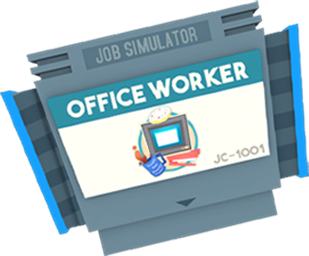


As Featured In

Jobs
Learn 'to job' with the following *exciting* historical re-creations!
Gourmet
Chef
Learn what it was like when cooking was a human task.
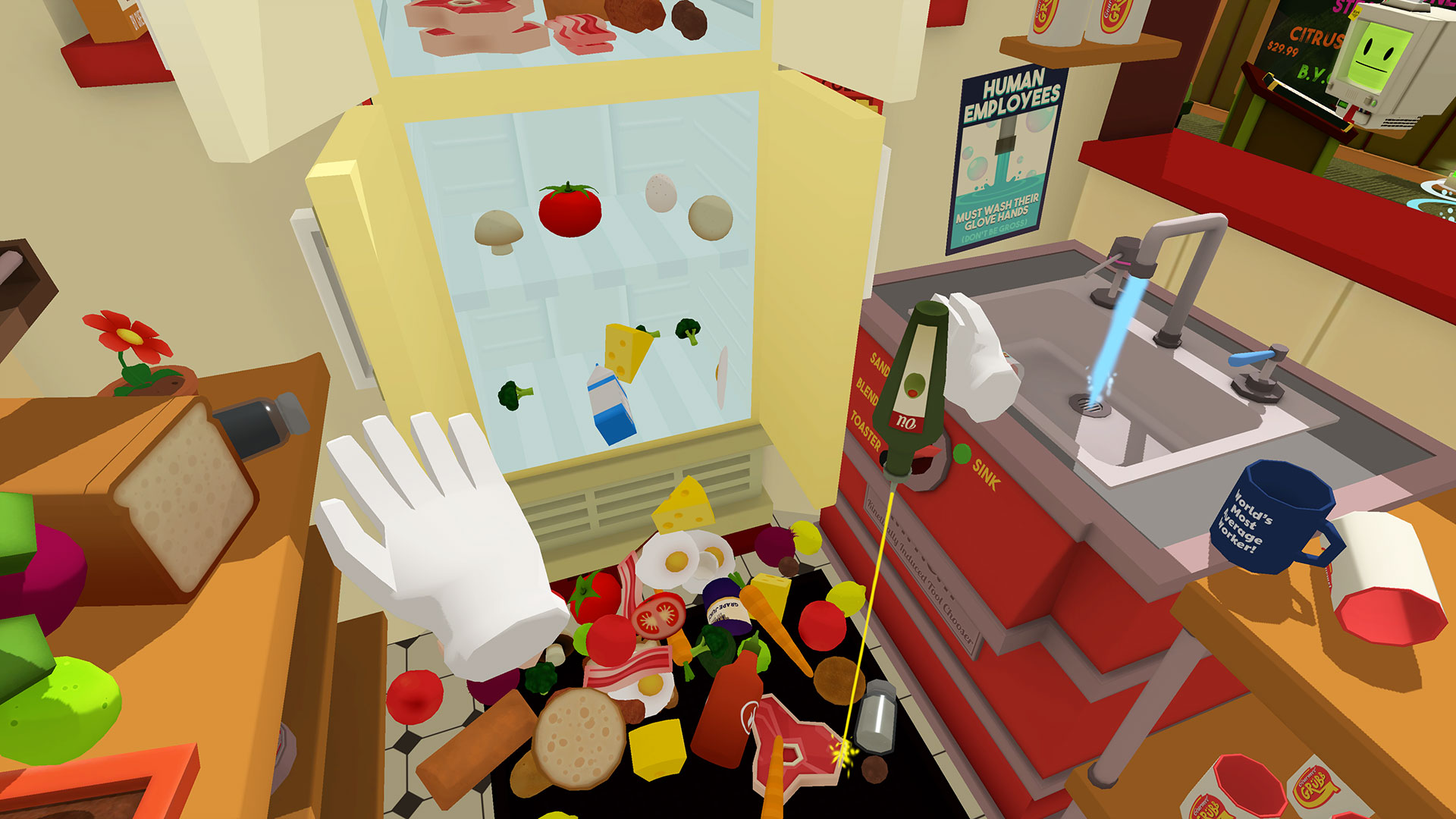
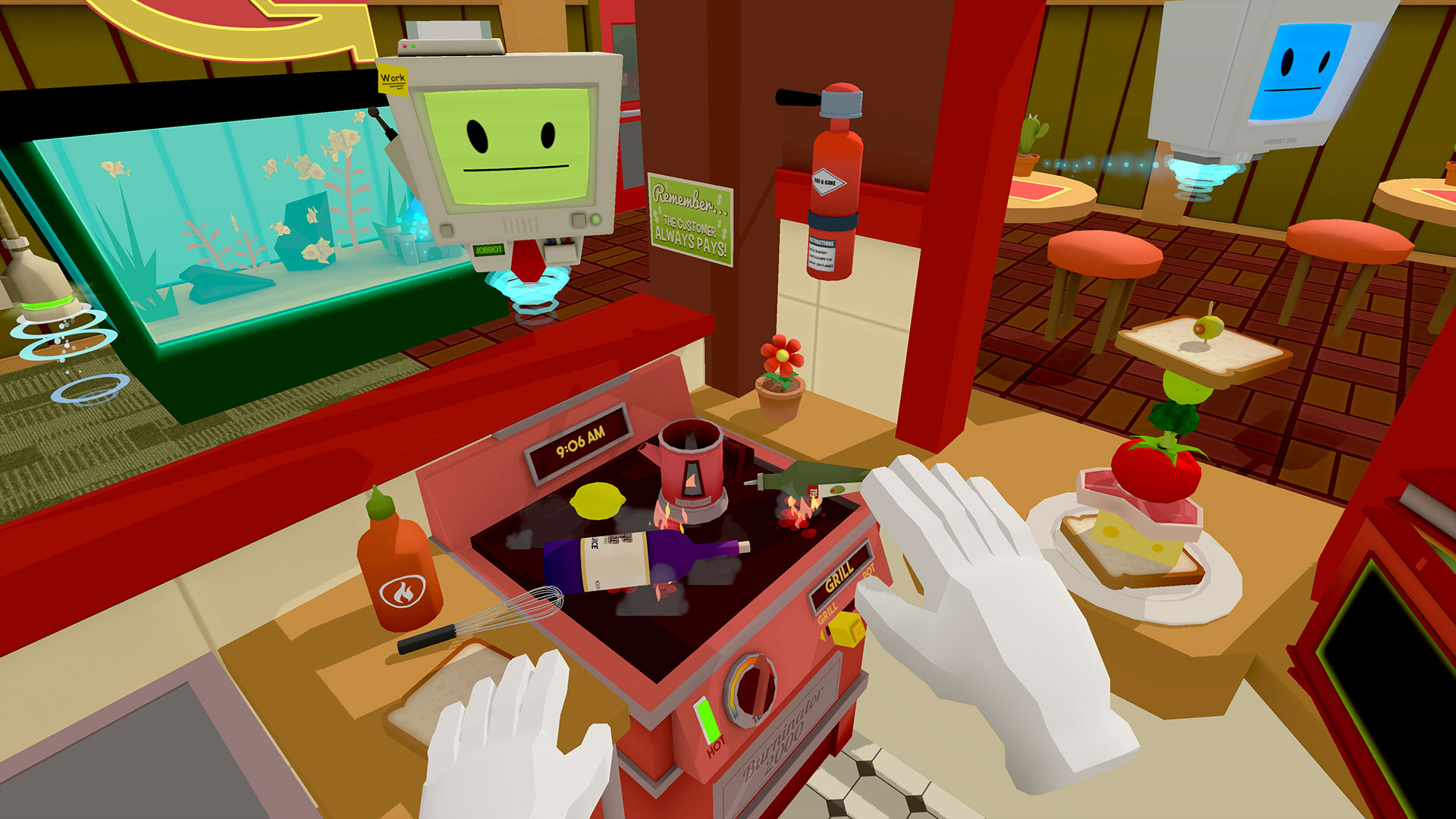
Office
Worker
Spend a day in the shoes of an office cubicle worker.
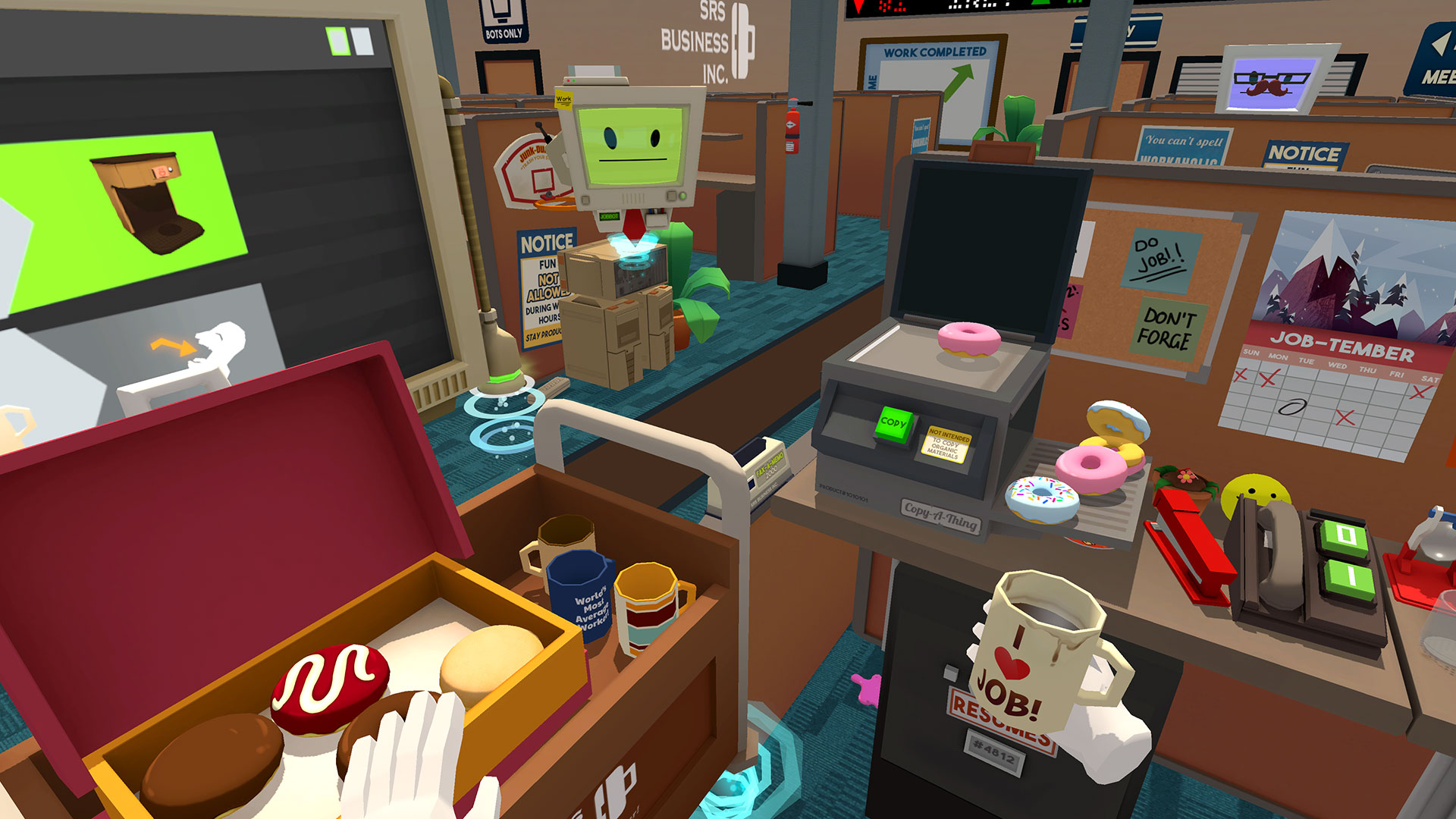

Convenience
Store Clerk
Manage customers as a convenience store clerk.

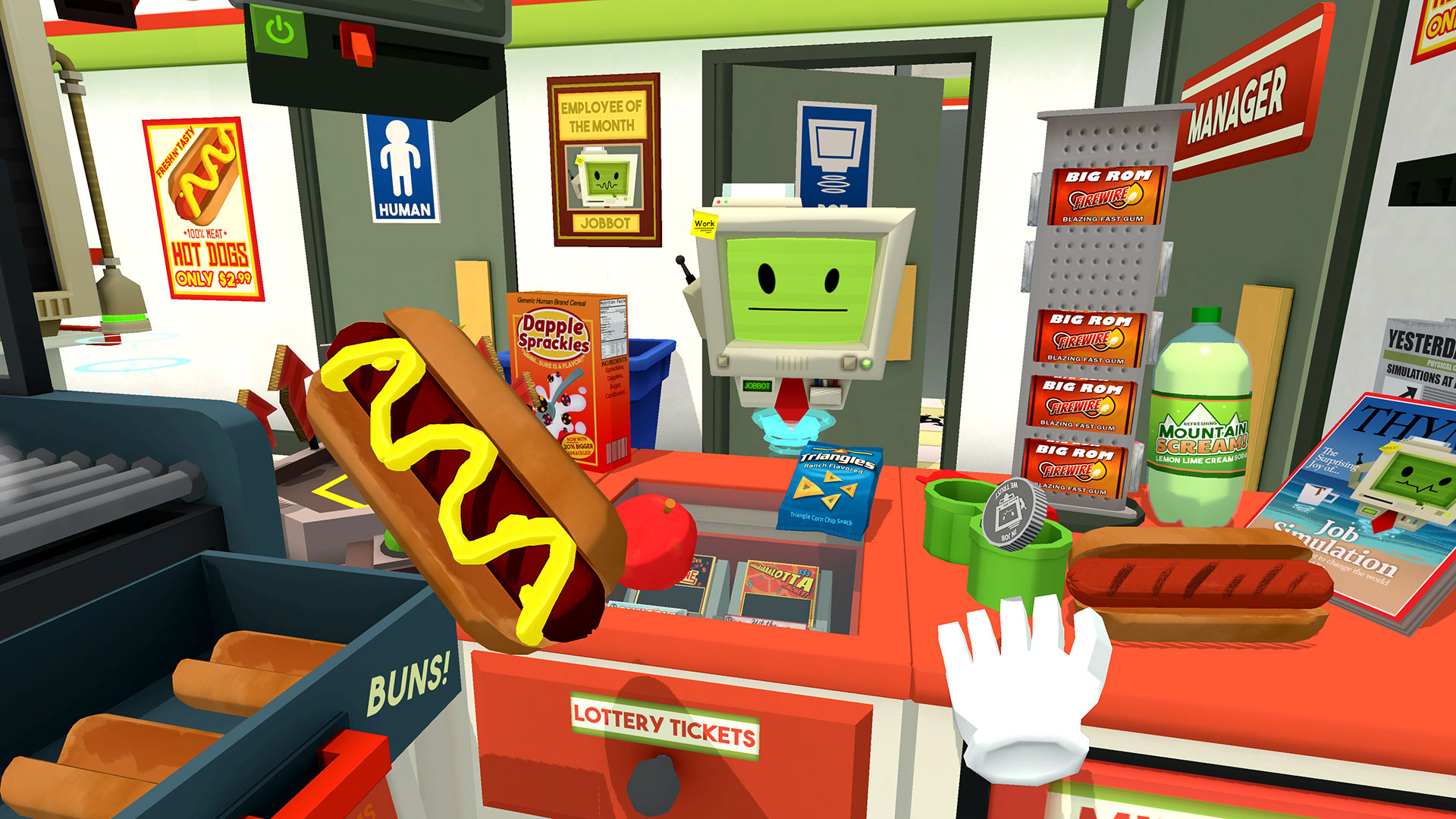
Automotive
Mechanic
Fix cars as an Automotive mechanic!


Press Reactions
Job Simulator was unveiled at the worldwide announce of the Vive at GDC 2015. Since then it's been announced as a launch title for Oculus Touch as well as PlayStation VR!

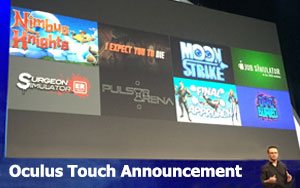
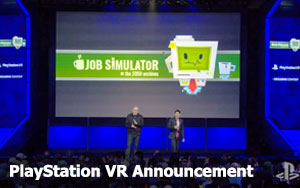
Here's what the press are saying:

I never expected a video game demo in which I grabbed a tomato (and threw it at a robot) to awe me so deeply.
I … wanna play Job Simulator forever.

It was riotously funny.
Of the game-like experiences I’ve had with the device, it was the best -
better even than Valve’s own Portal 2 vignette.

This digital kitchen I was transported to tricked me without even having me realize I had been duped.
I was tricked into believing.

My personal favourite was one where I was transported to a kitchen. I cooked in a virtual kitchen, and it felt
so unbelievably real.

I microwaved a tomato, served up a beef steak, and cracked many eggs.
This was actually the perfect demo for VR:
the rudimentary and clumsy actions I was performing reminded me of those of a young child that’s first getting to know the world around it.

I found myself in the kitchen for the first properly interactive experience of the demo. I soon discovered that there was as much fun to be had playing with the food as there was cooking with it.

The one that left the biggest lasting impression with me is probably the kitchen/cooking one... It just felt like a complete joy. Ringing the bell, picking up the various objects, opening the fridge... it all felt
incredibly natural and instinctive.

I threw pots and pans around a robot kitchen, chopped up carrots and mushrooms and then microwaved a bottle of wine (it melted into a twisted cube)... It sounds ridiculous, but
I was grinning like a lunatic the whole time.

It all felt natural and intuitive (and fun and ridiculous).

... perhaps the most impressive when it came to interaction.
Social VR: Spectator Mode
We've built a brand new way to allow viewers to experience the game.
We call it Spectator Mode and it's our latest way to do Social VR!
How do you enable Spectator Mode?
Click the camera ![]() in the bottom left of the window on the PC!
in the bottom left of the window on the PC!
Tip: Double-click the grip button on the controller to swap cameras!
Social VR: Mixed Reality
Mixed Reality is the best way we've found to explain the feeling
of being inside a VR game to non-VR viewers.

Social VR: Twitch Chat in-game
Now you can view, move, scale, and throw your Twitch chat in-game!
Read more about the Owlchemy Twitch view here: http://owlchemylabs.com/socaial-vr-twitch-chat-embedded-in-job-simulator/
The best HTC Vive games for 2020
Players looking for an engaging VR experience have no shortage of titles to choose from these days. What was once a gimmicky, proof-of-concept playground has turned into a burgeoning marketplace full of immersive experiences.
The HTC Vive is home to many of these games, and it offers users an expansive library of virtual reality experiences. If you’ve just picked up the Vive — or you’re a veteran VR player looking for your next adventure — you can’t go wrong with any of the following games.
Further Reading
Action
Until You Fall
Until You Fall is a roguelike action game where you run the same gauntlet of enemies over and over, upgrading your weapons and skills as you go. Although the enemy models and environments can get a bit repetitive, the gameplay is anything but. Until You Fall utilizes both of the motion controllers with a weapon in each hand. Instead of flailing your arms around and hoping for the best, Until You Fall features a fast parrying and blocking system.
In many ways, it feels like a rhythm game. Each enemy type attacks in different ways, and you’ll need to anticipate each upcoming move. As you block and dodge, you’ll slowly work chip away at your opponents’ defenses, opening up the opportunity for a devastating combo. Until You Fall not only showcases how well swordplay works in VR but also how intricate it can be.
Gorn
Gorn is a VR gladiator simulator from the developer of Broforce. The game doesn’t take itself too seriously going so far as to call the enemy animations “poor” on the Steam page. As with many VR titles, Gorn occasionally feels broken but in a charming way and remains endlessly fun to play. Ruthlessly violent, you can dispatch of foes any way you see fit be it with swords, maces, knives, war hammers, and more at your disposal.
It’s fully physics-driven, too, so you can interact with the game world and your enemies in a multitude of ways. You can plant a mace in an opponent’s head or use a sword to chop off a limb. Even as how blood-ridden and violent as Gorn is, it never gets too overwhelming. The cartoon graphics and constant jokes are enough to make the brutality of its subject matter feel digestible.
Swords of Gargantua
Virtual reality’s motion controllers are perfect for emulating sword fighting, and Swords of Gargantua is one of the best ways to live out your fantasies as a monster-slaying warrior. With 100 single-player missions and 30 included weapons, you won’t run out of enemies to kill anytime soon. With haptic feedback support for swords, it will feel like you’re really swinging a weapon.
If you get tired of playing alone, you can battle waves of enemies in four-player cooperative play, and it’s cross-platform compatible giving you more potential teammates. At a reasonable price, it’s one of the best values on Vive right now.
Raw Data
One of the best action games available in VR, Raw Data transports you into the future to take down an evil conglomerate. Eden Corporation controls the world, but as an operative from the underground hacking group SyndiK8, you go straight into the walls of the corporation to decimate the operation from within, siphoning as much data as possible.
The sci-fi setting is wonderfully realized, and the action-oriented gameplay puts you in total control of a wide range of weapons and nanotech powers. Raw Data is a challenging game that rewards players who take advantage of their entire arsenal of abilities. You can play solo or with a friend to uncover the true motives of Eden.
Eagle Flight
Showing off VR’s explorative strengths, Eagle Flight lets you take control of an eagle soaring over the streets of Paris. In this world, humans went extinct 50 years ago, and animals now have dominion over everything. Eagle Flight gives you a breathtaking vantage point over historic landmarks left behind such as the Eiffel Tower.
The action comes in as you swoop down to fight off other animals trying to hone in on your territory. The aerial dogfights are exciting, but perhaps most interesting when enjoyed via the game’s competitive multiplayer mode. Part of the appeal of VR is having experiences you otherwise couldn’t, and Ubisoft’s Eagle Flight does just that.
Thumper
Part of what makes virtual reality so exciting is its ability to dominate the player’s senses in a way that screens simply cannot. No game better exemplifies this than Thumper, a so-called “rhythm violence” game that puts players in control of a metallic beetle racing along a psychedelic highway to confront gigantic monsters. Players use simple, intuitive commands to avoid obstacles along the track, lean into turns, and hop over rails.
The hazards sync with the game’s soundtrack consisting of militant drums and ominous soundscapes. Even with the distance granted by a monitor, Thumper feels oppressive, but in virtual reality, it becomes a grinding descent into hell. While the game’s environments look great in VR, the boss fights are truly awe-inspiring. Massive, cosmic horrors are rarely as menacing as they are in VR.
Beat Saber
While not an officially licensed Star Wars game, it’s easy to see where the inspiration for this action music game came from. Wielding a pair of HTC Vive controllers, you smack at blocks with lightsabers to the rhythm of catchy instrumental tracks. Slashing through these blocks may not be as satisfying as slaying a Stormtrooper, but it’s pretty darn close.
Technically it’s still in early access, so more content, including a single-player campaign, is expected down the line. As it stands, Beat Saber has ten awesome tracks and multiple difficulty levels to master. Remember when Guitar Hero captivated the world way back when? Beat Saber captures that magic in the VR space.
Elite Dangerous
Elite Dangerous’s starfighter cockpit is a great way to justify a seated VR experience. Frontier planned to port the game to VR since the Oculus DK1, and that level of iteration shows in the final product’s polish.
Elite has a first-mover’s advantage of being one of the Vive’s launch titles longest in development with a successful, multi-platform release already under its belt. This open-world space game will be a natural starting point for gamers who want a polished, proven experience.
Shooter
Boneworks
Boneworks is a narrative-driven first-person shooter from Stress Level Zero, the same studio behind Duck Season. In many ways, the game feels like a tech demo of what VR is capable of. Using an advanced physics engine, you’re tasked with solving puzzles, dispatching enemies, and traversing the sci-fi world in creative ways. You can interact with nearly everything in the game world, too, bringing a level of immersion that no other VR title has been able to capture.
Outside of the Half-Life-inspired narrative, which is worthy of a mention in its own right, it’s the interactions in Boneworks that stand out most. If you see something, you can interact with it in the way you think you can. For instance, you can use a crowbar to open a locker door or stuff a flying enemy into a trash can and close the lid. Much like how Half-Life 2 showed how much physics can affect normal games, Boneworks shows how it can affect VR titles.
The Walking Dead: Saints and Sinners
Outside the Telltale titles, The Walking Dead: Saints and Sinners is easily the best Walking Dead game ever made, and it just happens to be in VR. Saints and Sinners takes place in New Orleans, but rather than the city filled with excellent food and party beads many are familiar with, this version is dilapidated and overrun with zombies. To make matters worse, there are warring factions within the city, and you’re caught in the middle.
If the subject matter didn’t stress the point enough, you send your character to sleep each night using a flask. Saints and Sinners captures the dark, moody tone of the TV series excellently and provides compelling combat on top of that. Like Boneworks, Saints and Sinners showcases how powerful VR can be for gaming.
Pistol Whip
Pistol Whip is technically a shooter, though it’s fairer to call it a rhythm game. You automatically move down a linear corridor with only a pistol, shooting, dodging, and punching like you’re John Wick in an over-saturated tech demo. Although the shooting is fun on its own, Pistol Whip sets its stages to music, and the more you time your attacks to the beat, the higher the score you’ll get.
Like Beat Saber, Pistol Whip fits perfectly into the VR experience. Unlike other rhythm games, however, which force you into a set beat, Pistol Whip allows you to shoot to your own tune. Locking into the pulse-pounding EDM tracks and sending bullets through the air is where Pistol Whip shines.
Superhot VR
Superhot VR turns an already innovative and exciting shooter puzzler into an even more memorable experience on the Vive. The stop time mechanic responds to movement from the player’s hands wielding the Vive controllers. Thanks to the precise tracking system offered by the Vive, fluid and precise movements can be made with little frustration.
The goal of Superhot VR is the same as the original — work your way through white rooms by dismembering foes with calculated movements. Superhot VR gets your adrenaline pumping and truly showcases how immersive VR can be. For that, it’s arguably the best experience available on Vive.
Rez Infinite
A remake of the 2001 cult classic Rez, Rez Infinite is a pitch-perfect VR adaptation that makes us feel as though Rez was always meant for VR. Rez Infinite is still the on-rails shooter that takes players through a hazard-filled computer network, but the all-encompassing chaos and enemies you must aim and shoot at pop when in VR.
There’s also something about the way the shifting environments — the lines, polygons, and bright flourishes — that comes alive when strapped into a headset. Combine the fast and enticing gameplay with the rhythmic soundtrack, and it’s easy to get fully immersed in the HTC Vive. Rez has aged remarkably well, but Rez Infinite in VR is the best way to play the iconic game.
Serious Sam VR: The First Encounter
Expanding on the surprise success of Serious Sam VR: The Last Hope, The First Encounter delivers a faithful remaster of the 2009 HD remake of the original entry in the series. Supporting both full locomotion and teleportation movement, The First Encounter lets you enjoy the fast-paced experience however you see fit.
The 15 campaign levels are even more fun than in the original thanks to the immersion of VR. You can also play cooperatively or in an arena-style competitive mode online. There’s also a horde mode that lets you link up with up to 15 other players to battle through waves of enemies.
Featuring full trackpad controls on Vive, Serious Sam VR: The First Encounter successfully replicates controller play while giving you increased precision.
Arizona Sunshine
According to your radio, there are survivors of the zombie apocalypse other than yourself, and it’s your job to go on the grueling journey through the southwestern heat to reach humanity. Yes, Arizona Sunshine is yet another game filled with flesh-devouring zombies, but it’s in VR.
Getting chased by the undead becomes a lot less blasé when you feel like you’re really there. When exploring the game’s vast, barren world, a pack of zombies is never far behind. Arizona Sunshine‘s campaign is playable solo and cooperatively. When you’re done, there is a proper horde mode to get at with up to four players.
Space Pirate Trainer
Space Pirate Trainer stands out from the mass of shooting galleries on the Vive with its tight controls and gorgeous presentation, which gives players an experience straight out of an ’80s sci-fi film.
The game largely takes place on an isolated platform. Players hold the Vive controllers in their hands, each one acting as an in-game gun. These guns can be set to perform a variety of actions, allowing you to fire in bursts or using powerful charged shots.
Increasingly difficult waves of robotic enemies emerge, and you must shoot them down while dodging their attacks. This simple gameplay is surprisingly fun, however, as it gets you moving and multitasking. There are few VR experiences more thrilling than twirling around incoming lasers and firing back, guns akimbo.
Hover Junkers
While many of the titles currently available seem more like proofs of concept than anything else, Hover Junkers is a fully-realized and exciting multiplayer experience that has us hooked. It solves the problem of moving in a limited space by turning your small play area into the deck of a hover ship that you use to fly around the battlefield, collect junk, and trade blasts with your opponents. Collected junk can be used to bolster your defenses, creating walls for you to crouch behind. Shooting and reloading are handled with natural gestures.
Piloting around, ducking behind cover, and popping up to shoot at your enemies is as intuitive and immersive as any first-person shooter we’ve ever played, so Hover Junkers serves as a fantastic ambassador for the genre.
Doom VFR
Few first-person shooters have ever been as smooth, outrageous, and downright fun as 2016’s Doom reboot. Capturing everything great about the original two games, it felt like a direct response to the overly serious and methodical tone of modern AAA titles.
Doom VFR — yes, the “F” means exactly what you think it does — adapts the speedy experience of thrill-killing demons for VR, with a new tale of a “cybernetic survivor” tasked with fending off a demonic invasion on the Mars-based research facility.
Read our full Doom VFR review
Adventure
Duck Season
Duck Season takes you back to the summer of 1988. Your mom comes home with a stack of games for your Kingbit Entertainment System, many of which mimic classic NES games. Among the lot is a Dunk Hunt clone, and unlike the other titles, you’re transported into the virtual world to, well, hunt ducks. There, the iconic dog from the original game still taunts you, but it seems more menacing than before. Clearly someone dressed in a dog costume, the character becomes increasingly involved in the boy’s life, eventually transitioning out of the game world.
It should be clarified that Duck Season is a horror title, so be warned. That’s all we’ll spoil about it, however. Featuring multiple subplots, various mini-games, and seven unique endings, Duck Season is a creative, narrative-driven experience built from the ground up for VR.
Fujii
Take a break from the violence and lifelike combat found in so many Vive games and instead relax in the tranquil world of Fujii. Part narrative adventure and part gardening simulator, you’ll explore the colorful, peaceful areas of Fujii and gradually restore life to its biomes and interact with plants. As you travel and collect seeds, you can then plant them in your own home garden for a custom creation unlike anyone else’s.
Much of the joy in Fujii comes from its gorgeous environments, which range from lush greenery to abstract white gardens and ponds topped with lily pads. The plants you grow will even contain musical elements, and you can bring back animals and smaller insects to their new home in your garden.
Trover Saves the Universe
From the bizarre and eccentric mind of Rick and Morty co-creator Justin Roiland comes Trover Saves the Universe. Completely separate from the hit show but featuring the same art direction and sense of humor, Trover Saves the Universe is an adventure game loaded up with different gameplay opportunities, including platforming and combat. All throughout, you’ll be treated to Roiland’s unique brand of sarcasm, and you can upgrade Trover to help on your adventure.
Trover Saves the Universe will continue to evolve over time as well. Future content for the game will be released for free, and you have options for how you play it. The game is fully compatible with Vive, or you can play it on a traditional display.
Adr1ft
If you watched Gravity and thought, “Gosh, I’d love to see how terrified I would get if I were stranded alone in space,” Adr1ft gives you the chance to find out. At the start of the game, you wake up completely alone in the vast silence of space.
Remnants of your destroyed space station float around you, but you don’t really understand the significance of that event because you have no memory. Even worse, your oxygen suit is gradually failing, constantly threatening death by suffocation in the void among the nameless stars.
The main draw of Adr1ft ends up being its stunning visuals. You truly will feel as if you are there. Throughout the roughly four hour experience, you will mostly be gazing at the environments while slowing trying to save yourself. Admittedly, the controls can be rough, but as a visual display, Adr1ft is certainly worth checking out.
Moss
Many virtual reality games commit to the first-person perspective and have you embody the character you’re controlling, but Moss takes a different approach. The action-adventure game tasks you with controlling a small mouse from a third-person perspective, engaging in combat and moving throughout the world much like you would in a traditional game.
The world itself, however, is controlled by you, and you can use this to your advantage as you solve puzzles and clear obstacles. Moss’ storybook-like tale and the setting is also perfectly suitable for younger players, provided they can handle VR.
Read our full Moss review
Job Simulator: The 2050 Archives
Life is rather boring in 2050. Every job has replaced humans with robots, and now you’re feeling a bit underwhelmed. To keep yourself busy, you strap on a VR headset and see what it was like to work menial jobs. In Job Simulator: The 2050 Archives, you can work as a convenience store clerk, a mechanic, a chef, and an office worker.
As mundane as that may sound, it turns out that everyday tasks are much more enthralling in VR. It helps that Job Simulator has quirky humor, but for the most part, the experience excels because almost everything you see is a point of interaction. Simply picking up, moving, and throwing things in VR is a joy.
Vacation Simulator
If you’re getting tired from the work you’re doing in Job Simulator, Owlchemy Labs still has you covered with Vacation Simulator. The game takes the adventure to sunny beaches and snowy mountaintops as you play ball, grill delicious meals, swim in the pool, or just goof around. You can even go hiking, but without the bug bites and dirt that usually ruin such an experience. There usually aren’t robots hanging around when you take a real vacation, either.
Vacation Simulator is a lighter VR game, and it is less likely to cause sickness issues than more intense offerings. Owlchemy Labs’ sense of humor shines through in the new setting, and it’s a game that can truly only exist within VR.
Star Trek: Bridge Crew
The closest you will come to living out your dreams on the Enterprise, Star Trek: Bridge Crew does an exceedingly good job at capturing the essence of a Star Trek space battle in VR. You explore the stars and universe with a team of four aboard your spaceship.
One pilots the ship, another serves as an engineer, and another makes tactical choices. The fourth teammate is the captain looking over all of the work at a global level. As a team-oriented experience, Bridge Crew is at its absolute best when you have three friends to play with. If you’re remotely interested in Star Trek and have someone to play with, you shouldn’t miss it.
Read our full Star Trek: Bridge Crew review
Accounting+
Is virtual reality a good medium for comedy? Accounting, a short adventure game written by Rick and Morty creator Justin Roiland, makes a strong case for it. Navigating through many colorful, deranged layers of reality, players can grab and move objects in the world, and, for the most part, the only thing they have to do is fiddle with their surroundings.
While the mechanics may not be memorable, the writing certainly is. Populated by bizarre characters who speak in rambling, absurd dialogue, fans of the show, or animated comedy in general, will undoubtedly love this short but memorable VR vignette.
Silicon Valley: Inside the Hacker Hostel
The HBO show Silicon Valley gives you a look into the world’s most dysfunctional technology company, Pied Piper, and with the free Silicon Valley: Inside the Hacker Hostel game, you can be a cog in the barely-oiled machine.
The game features several of the show’s biggest characters, including Jared, Jian Yang, Big Head, Richard, Dinesh, and Gilfoyle, as well as a fully functional bong, in case you need something to give you a little creative inspiration.
Viveport
Role-playing
Fallout 4 VR
Fallout 4 is one of the most ambitious role-playing games of all time, combining an improved combat system with Bethesda’s legendary world-building and quest design. Fallout 4 VR throws you into the game to live our your vault-dwelling dreams in virtual reality — not just a small section of the game, but the entire experience.
With the stop-and-go V.A.T.S. combat system and a slower movement speed than comparable virtual reality titles, Fallout 4 VR can be played for long stretches of time, and given the size of Bethesda’s world and the amount of content it holds, that is a very good thing.
Read our full Fallout 4 VR review
The Elder Scrolls V: Skyrim VR
Nobody can create an open world quite like Bethesda Game Studios, and The Elder Scrolls V: Skyrimjust might be the developer’s masterpiece. In The Elder Scrolls V: Skyrim VR, you can experience the entire game in virtual reality, and it looks even better on HTC Vive than it does on platforms like PlayStation VR.
Traveling throughout Skyrim and battling Draugr in secret caves feels more immersive than it did in the original game, and you can truly become the character you’ve created. Every decision has a newfound sense of weight and meaning, and every battle feels that much more important.
Read our full Skyrim VR review
Puzzle
Keep Talking and Nobody Explodes
Virtual reality headsets seem like an isolating experience at first, and though it’s possible to mirror the visuals to a screen for the sake of people around you, there is no way to convey the same experience you’re having. Keep Talking and Nobody Explodes is a unique multiplayer experience that offers a way for people not wearing the headset to participate.
The game tasks the player wearing the headset with disarming a bomb with input from other players. The problem? Only the player wearing the headset can see the bomb. In order to disarm it, the main player must describe the various modules on the bomb, while the other players consult a lengthy manual that offers instructions on what to do.
The result is tense, and often frantic experience as players shout at each other while the clock ticks down. The modules that appear on the bomb appoint players with various tasks, such as translating morse code or playing memory games, and communication is vital; it can also break down quickly. The asymmetric gameplay of Keep Talking and Nobody Explodes is great fun and provides a much-needed template for socially-oriented VR games.
Fantastic Contraption
The Vive’s motion controls and use of actual, physical space opens up some exciting possibilities for games that really let you get your hands dirty, and Fantastic Contraption is a perfect example. Based on a flash game from 2008 of the same name, Fantastic Contraption tasks you with using simple components such as wheels and rods, to construct devices that move a goal object through the level and into the goal area. It’s conceptually reminiscent of the old Incredible Machine series, but with simpler components and a greater focus on physics.
Unlike its predecessor where you simply used the mouse to connect parts and construct 2D contraptions, now you manipulate components directly with your hands in full 3D. The concept translates beautifully into the new medium, and getting down on your hands and knees to tinker with your contraption is gratifyingly immersive.
Mr. Mercedes Lair Escape
Why pay money to go to an escape room when you can experience all the same thrills and frustration from the comfort of your living room? In Mr. Mercedes Lair Escape, a puzzle game based on the AT&T television show and Steven King novel, you’re tasked with escaping from a locked-down lair before time expires, and footage from the set of the show has been used directly in the experience. It’s a disturbing and dark take on the escape room that borders on psychological horror, which just makes actually figuring out the way to exit the room even more stressful.
Viveport
Tetris Effect
A sublime and wholly original take on the classic puzzle game, Tetris Effect shows just how important a game’s visual and audial cues can be to shaping the experience. At its most basic level, Tetris Effect is still classic Tetris, but Tetris Effect uses crescendos and your own moves to shape the game’s soundtrack. As you continue to clear lines and make your way through different stages, the pieces will change design, as will the environments behind them.
Tetris Effect gets its name from the phenomenon of players seeing pieces wherever they look — even in their dreams — even after putting the game down. For this reason, the HTC Vive is the perfect place to experience the game as you’ll be sure to still watch blocks fall when you close your eyes.
Social and creative
Richie’s Plank Experience
Many people are at least a little afraid of heights, particularly when they’re near the top of a skyscraper without a barrier to prevent them from falling. In Richie’s Plank Experience, you can attempt to overcome that fear by walking on a narrow plank of wood 80 floors up in the air.
The developers even suggest using an actual wooden plank in your playing space, and you can customize the in-game plank’s dimensions to match the one you’re using in real life.
Rec Room
A social VR experience, Rec Room gives players the ability to hang out and play colorful mini-games with other players. As you control an avatar, you can play basketball, soccer, paintball, disc golf, charades, and more, and all of it is played with room-scale VR that really immerses you in the action.
Rec Room is one of the more relaxed experiences available on the HTC Vive, and since it’s in early access, more mini-games are expected to be added over time. As it stands, Rec Room is free to download and play, making it a no-brainer for HTC Vive owners.
Steam
Tilt Brush
Tilt Brush isn’t a game, per se, but it’s easily one of the most engrossing and medium-specific applications currently available for the Vive. This Google-owned app utilizes the two motion controllers as a brush and palette, allowing you to paint in 3D space.
Tilt Brush lacks the kind of advanced features that would allow you to create 3D models or even geometric forms. However, it’s a fun platform for sketching your ideas in a 3D environment.
Tilt Brush is an interesting entry in the HTC Vive catalog because it’s not a simple port of an existing game. It’s a creative platform designed specifically for a VR experience, and activities like virtual painting and sculpting could open up new possibilities for devices like the HTC Vive.
Editors' Recommendations
What’s New in the full Steam VR support Archives?
Screen Shot

System Requirements for Full Steam VR support Archives
- First, download the Full Steam VR support Archives
-
You can download its setup from given links:



